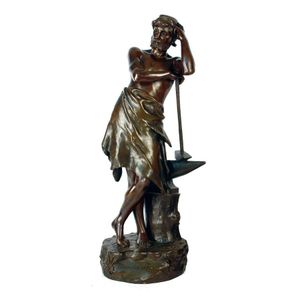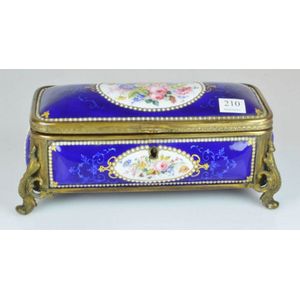Victorian Gothic Oak Hall Chair in Pugin Style
You must be a subscriber, and be logged in to view price and dealer details.
Subscribe Now to view actual auction price for this item
When you subscribe, you have the option of setting the currency in which to display prices to $Au, $US, $NZ or Stg.
- Gothic Style, Furniture - Gothic style furniture refers to pieces that are designed and crafted in the Gothic architectural and decorative style that was popular in Europe from the 12th to the 16th centuries. This style of furniture is characterised by its elaborate and ornate details, as well as its use of dark and heavy woods, such as oak and walnut.
Gothic style furniture often features intricate carvings and embellishments, including pointed arches, quatrefoils, and tracery. The style also frequently incorporates elements such as coats of arms, shields, and religious symbols. Gothic furniture often has a heavy and substantial appearance, and the pieces are often finished with a dark stain to accentuate the detailed carving and embellishments.
The furniture items can be quite large and imposing, and they are often used as statement pieces in large rooms. Gothic furniture can be a striking and dramatic addition to any space, and it is often appreciated by those who have an interest in medieval and historical design. - Victorian Period - The Victorian period of furniture and decorative arts design covers the reign of Queen Victoria from 1837 to 1901. There was not one dominant style of furniture in the Victorian period. Designers used and modified many historical styles such as Gothic, Tudor, Elizabethan, English Rococo, Neoclassical and others, although use of some styles, such as English Rococo and Gothic tended to dominate the furniture manufacture of the period.
The Victorian period was preceded by the Regency and William IV periods, and followed by the Edwardian period, named for Edward VII (1841 ? 1910) who was King of the United Kingdom and the British Dominions and Emperor of India for the brief period from 1901 until his death in 1910. - Pugin - Augustus Welby Northmore Pugin, (1812-52) was an architect and designer and leader of the Gothic Revival movement which was so important an influence on Victorian taste. His father had an architectural drawing school, and artists from that school, including Pugin, then 15 years old, were employed to make drawings of the furniture to be taken to Windsor palace. Later in the year he was employed to design and make working drawings of furniture for the palace. He also designed silver for the royal goldsmiths Rundell Bridge & Rundell. By the 1830s he was insisting on historical accuracy, and published a number of influential books on the Gothic style. He was responsible for furniture in the Houses of Parliament (1836-7) the design of the tower that houses Big Ben. He became a Catholic in 1833, and he and his son Edward Welby Pugin (1834-75) designed and built several churches. In his short life, he married three times. After his death Pugin's two sons, Edward Welby Pugin and Peter Paul Pugin, continued operating their father's architectural firm under the name Pugin & Pugin.
- Manner of .... / Style of ..... - A cataloguing term where the item, in the opinion of the cataloguer is a work in the style of the artist, craftsman or designer, possibly of a later period.
- Oak - Native to Europe and England, oak has been used for joinery, furniture and building since the beginning of the medieval civilisation. It is a pale yellow in colour when freshly cut and darkens with age to a mid brown colour.
Oak as a furniture timber was superceded by walnut in the 17th century, and in the 18th century by mahogany,
Semi-fossilised bog oak is black in colour, and is found in peat bogs where the trees have fallen and been preserved from decay by the bog. It is used for jewellery and small carved trinkets.
Pollard oak is taken from an oak that has been regularly pollarded, that is the upper branches have been removed at the top of the trunk, result that new branches would appear, and over time the top would become ball-like. . When harvested and sawn, the timber displays a continuous surface of knotty circles. The timber was scarce and expensive and was used in more expensive pieces of furniture in the Regency and Victorian periods. - Rail - A term used by cabinet makers for the horizontal sections of the frame of an item such as a chair or settee which have a front rail, a back rail and two side rails, and also on a door or carcase, where the rails are joined to the vertical framings.
This item has been included into following indexes:
-
chairs, singles / pairs / threes, style or period
- dining 252
- hall 216
- Savonarola, curule or X chairs 48
- chairs, singles / pairs / threes, timber - oak 497
Visually similar items

An uncommon Royal Doulton 'Kiwi' tea set comprising teapot, milk jug and sugar bowl each with an encircling band decorated with multiple kiwis on a simulated crackle ground, each piece with Bates & Co., Dunedin Exhibition 1925-26 stamp under the base

A finely modelled 19th century French bronze by J. Berthoz entitled 'Sac Et Stera' (Do and Hope), represented as a blacksmith standing bare-chested beside his anvil, signature and entitlement to the base, foundry marks to the reverse, original patina. Heig

A large set of brass standing beam scales, with dolphin and snakes head motifs and the base inset with gram weights up to 0.5kg. Height 86 cm

A French gilt metal and enamel jewelled casket, late 19th century, height 8.5 cm, width 20 cm, depth 9 cm
